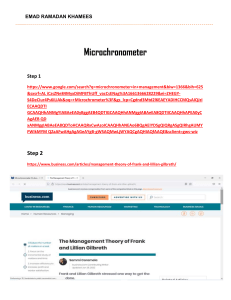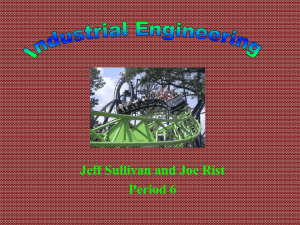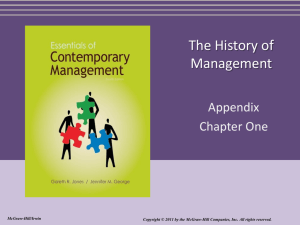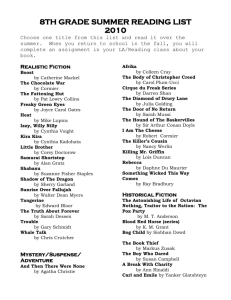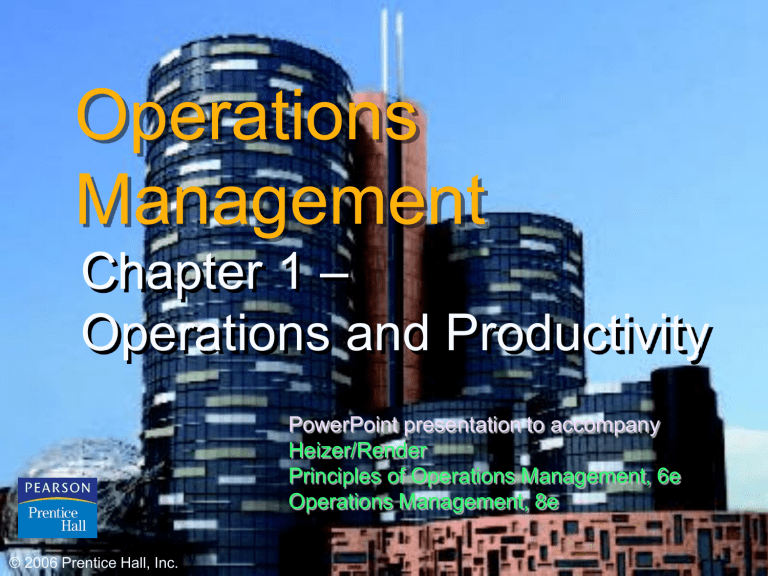
Operations Management Chapter 1 – Operations and Productivity PowerPoint presentation to accompany Heizer/Render Principles of Operations Management, 6e Operations Management, 8e © 2006 Prentice Hall, Inc. 1–1 Learning Objectives When you complete this chapter, you should be able to: Identify or Define Production and Productivity Operations Management (OM) What Operations Managers do Services 1–2 What Is Operations Management? Production is the creation of goods and services Operations management (OM) is the set of activities that creates value in the form of goods and services by transforming inputs into outputs 1–3 Operations Management (OM) -is the administration of business practices to create the highest level of efficiency possible within an organization. - It is concerned with converting materials and labor into goods and services as efficiently as possible to maximize the profit of an organization. - Operations management teams attempt to balance costs with revenue to achieve the highest net operating profit possible. 1–4 Understanding Operations Management (OM) Operations management involves utilizing resources from staff, materials, equipment, and technology. Operations managers acquire, develop, and deliver goods to clients based on client needs and the abilities of the company. INPUTS OUTPUTS 1–5 5 M’s of Management Money Manpower Machines Materials Methods 1–6 Organizing to Produce Goods and Services Essential functions: Marketing – generates demand Production/operations – creates the product Finance/accounting – tracks how well the organization is doing, pays bills, collects the money 1–7 Organizational Charts Commercial Bank Operations Finance Marketing Teller Scheduling Check Clearing Collection Transaction processing Facilities design/layout Vault operations Maintenance Security Investments Security Real estate Loans Commercial Industrial Financial Personal Mortgage Accounting Auditing Trust Department Figure 1.1(A) 1–8 Organizational Charts Airline Operations Ground support equipment Maintenance Ground Operations Facility maintenance Catering Flight Operations Crew scheduling Flying Communications Dispatching Management science Finance/ accounting Accounting Payables Receivables General Ledger Finance Cash control International exchange Marketing Traffic administration Reservations Schedules Tariffs (pricing) Sales Advertising Figure 1.1(B) 1–9 Organizational Charts Manufacturing Operations Facilities Construction; maintenance Production and inventory control Scheduling; materials control Quality assurance and control Supply-chain management Manufacturing Tooling; fabrication; assembly Design Product development and design Detailed product specifications Industrial engineering Efficient use of machines, space, and personnel Finance/ accounting Disbursements/ credits Receivables Payables General ledger Funds Management Money market International exchange Capital requirements Stock issue Bond issue and recall Marketing Sales promotion Advertising Sales Market research Process analysis Development and installation of production tools and equipment Figure 1.1(C) 1 – 10 Why Study OM? OM is one of three major functions (marketing, finance, and operations) of any organization We want (and need) to know how goods and services are produced We want to understand what operations managers do OM is such a costly part of an organization 1 – 11 Options for Increasing Contribution Marketing Option Current Sales Cost of Goods Gross Margin Finance Costs Subtotal Taxes at 25% Contribution $100,000 – 80,000 20,000 – 6,000 14,000 – 3,500 $ 10,500 Finance/ Accounting Option Increase Reduce Sales Finance Revenue 50% Costs 50% $150,000 – 120,000 30,000 – 6,000 24,000 – 6,000 $ 18,000 $100,000 – 80,000 20,000 – 3,000 17,000 – 4,250 $ 12,750 OM Option Reduce Production Costs 20% $100,000 – 64,000 36,000 – 6,000 30,000 – 7,500 $ 22,500 1 – 12 What Operations Managers Do Basic Management Functions Planning Organizing Staffing Leading Controlling 1 – 13 Functions of Management 1. Planning is the function of management that involves setting objectives and determining a course of action for achieving those objectives. 1 – 14 Managers first need to develop a detailed action plan. In the planning phase, management should identify the goals and create a reasonable course of action to attain them. There may be multiple ways to achieve the goal, but it's management's responsibility to determine the best course of action. 1 – 15 Three Different Types of Planning in Management include: Strategic: A long-term, high-level type of foundational planning that emphasizes the mission, values, and vision of the organization. Upper management drafts its strategic plans, and all managers should refer back to the strategic plans to guide their decisions. 1 – 16 Tactical: A short-term (one year or less), objective-focused type of planning, often carried out by middle management. Operational: A plan that describes the daily roadmap of the activities within the company. Low-level managers and supervisors devise operational strategies in most cases. 1 – 17 Functions of Management 2. Organizing is the function of management that involves developing an organizational structure and allocating human resources to ensure the accomplishment of objectives. 1 – 18 Organizing The organizing function consists of taking the previously created plan and putting it into action. Key activities in this function include: • Identifying all of the necessary steps of the project. • Determining who will complete the actions • Establishing levels of authority and responsibility for every individual involved 1 – 19 Functions of Management 3. Leading is motivating and influencing employees to do the work and meet performance standards. Examples of effective leadership skills that managers can focus on include frequent and clear communication, expressing empathy, being an active listener, maintaining transparency, and empowering the team to perform to the best of their ability. 1 – 20 Functions of Management 4. Controlling involves ensuring that performance does not deviate from standards. Controlling consists of three steps, which include 1. Establishing performance standards, 2. Comparing actual performance against standards, and 3. Taking corrective action when necessary. 1 – 21 Ten Critical Decisions Ten Decision Areas 1. Service and Product Design 2. Quality Management 3. Process and Capacity Design 4. Location 5. Layout Design 6. Human Resources, Job Design 7. Supply-chain Management 8. Inventory Management 9. Scheduling 10.Maintenance 1 – 22 The Critical Decisions Service and product design What good or service should we offer? How should we design these products and services? Quality management How do we define quality? Who is responsible for quality? Table 1.2 (cont.) 1 – 23 The Critical Decisions Process and capacity design What process and what capacity will these products require? What equipment and technology is necessary for these processes? Location Where should we put the facility? On what criteria should we base the location decision? Table 1.2 (cont.) 1 – 24 The Critical Decisions Layout design How should we arrange the facility and material flow? How large must the facility be to meet our plan? Human resources and job design How do we provide a reasonable work environment? How much can we expect our employees to produce? Table 1.2 (cont.) 1 – 25 The Critical Decisions Supply-chain management Should we make or buy this component? Who are our suppliers and who can integrate into our e-commerce program? Inventory, material requirements planning, and JIT How much inventory of each item should we have? When do we re-order? Table 1.2 (cont.) 1 – 26 The Critical Decisions Intermediate and short–term scheduling Are we better off keeping people on the payroll during slowdowns? Which jobs do we perform next? Maintenance Who is responsible for maintenance? When do we do maintenance? Table 1.2 (cont.) 1 – 27 Sales = 50,000 Cost of Goods = 38,000 (76%) Finance Cost = 3,000 Taxes = 25% Assumptions: 1. Solve for the current Net Income 2. Increase Sales to 40% 3. Reduce Finance Cost to 40% 4. Reduce Production Cost to 20% 1 – 28 Where are the OM Jobs? Technology/methods Facilities/space utilization Strategic issues Response time People/team development Customer service Quality Cost reduction Inventory reduction Productivity improvement 1 – 29 Significant Events in OM Figure 1.3 1 – 30 The Heritage of OM Division of labor (Adam Smith 1776; Charles Babbage 1852) Standardized parts (Whitney 1800) Scientific Management (Taylor 1881) Coordinated assembly line (Ford/ Sorenson/Avery 1913) Gantt charts (Gantt 1916) Motion study (Frank and Lillian Gilbreth 1922) Quality control (Shewhart 1924; Deming 1950) 1 – 31 The Heritage of OM Computer (Atanasoff 1938) CPM/PERT (DuPont 1957) Material requirements planning (Orlicky 1960) Computer aided design (CAD 1970) Flexible manufacturing system (FMS 1975) Baldrige Quality Awards (1980) Computer integrated manufacturing (1990) Globalization (1992) Internet (1995) PERT: Program evaluation and review techniques CPM: Critical Path Method 1 – 32 Eli Whitney Born 1765; died 1825 In 1798, received government contract to make 10,000 muskets Showed that machine tools could make standardized parts to exact specifications Musket parts could be used in any musket 1 – 33 Frederick W. Taylor Born 1856; died 1915 Known as ‘father of scientific management’ In 1881, as chief engineer for Midvale Steel, studied how tasks were done Began first motion and time studies Created efficiency principles 1 – 34 Taylor’s Principles Management Should Take More Responsibility for: Matching employees to right job Providing the proper training Providing proper work methods and tools Establishing legitimate incentives for work to be accomplished 1 – 35 Frank & Lillian Gilbreth Frank (1868-1924); Lillian (18781972) Husband-and-wife engineering team Further developed work measurement methods Applied efficiency methods to their home and 12 children! Book & Movie: “Cheaper by the Dozen,” book: “Bells on Their Toes” 1 – 36 Frank and Lillian Gilbreth stressed one way to get the job done. Frank and Lillian Gilbreth valued efficiency by identifying and replicating one best way to complete a task. Husband and wife Frank and Lillian Gilbreth believed in regulation and consistency in the workplace. Rather than encouraging a company of many working parts, they valued efficiency above all else. The couple believed that there is one best way to get any job done, and the specific process should, when identified, be replicated through the manufacturing process, eliminating individual steps and producing the most efficient results. 1 – 37 Henry Ford Born 1863; died 1947 In 1903, created Ford Motor Company In 1913, first used moving assembly line to make Model T Unfinished product moved by conveyor past work station Paid workers very well for 1911 ($5/day!) 1 – 38 an American industrialist and business magnate, founder of the Ford Motor Company, and chief developer of the assembly line technique of mass production. By creating the first automobile that middle-class Americans could afford, he converted the automobile from an expensive curiosity into an accessible conveyance that profoundly impacted the landscape of the 20th century. 1 – 39 W. Edwards Deming Born 1900; died 1993 Engineer and physicist Credited with teaching Japan quality control methods in postWW2 Used statistics to analyze process His methods involve workers in decisions 1 – 40 Contributions From Human factors Industrial engineering Management science Biological science Physical sciences Information science 1 – 41 New Challenges in OM From To Local or national focus Global focus Batch shipments Just-in-time Low bid purchasing Supply chain partnering Lengthy product development Rapid product development, alliances Standard products Mass customization Job specialization Empowered employees, teams 1 – 42 Characteristics of Goods Tangible product Consistent product definition Production usually separate from consumption Can be inventoried Low customer interaction 1 – 43 Characteristics of Service Intangible product Produced and consumed at same time Often unique High customer interaction Inconsistent product definition Often knowledge-based Frequently dispersed 1 – 44 Goods Versus Services Attributes of Goods (Tangible Product) Attributes of Services (Intangible Product) Can be resold Can be inventoried Some aspects of quality measurable Selling is distinct from production Product is transportable Reselling unusual Difficult to inventory Quality difficult to measure Site of facility important for cost Often easy to automate Revenue generated primarily from tangible product Selling is part of service Provider, not product, is often transportable Site of facility important for customer contact Often difficult to automate Revenue generated primarily from the intangible service Table 1.3 1 – 45
